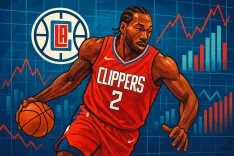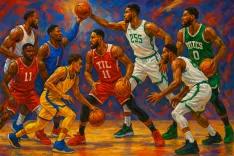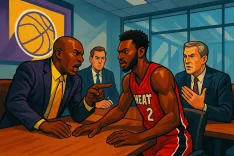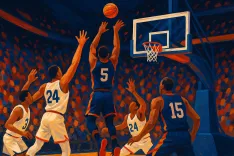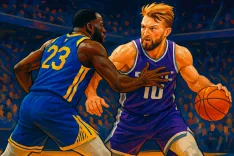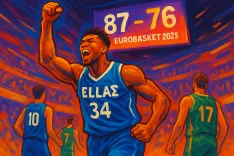Navigating Financial Decisions: NBA Teams Prepare for 2025-26 Season

In the NBA, every decision—whether proactive or reactive—carries inherent risk. Teams often spend the summer laying the groundwork for their rosters through the draft, free agency, and trades. While significant in-season moves, like a potential blockbuster involving Luka Dončić, can alter a team's direction, it is during the summer when the most impactful changes typically occur. Given the league's salary cap, luxury tax structures, and financial aprons, the intersection of financial strategy and basketball performance is unavoidable. Each franchise faces crucial choices that impact both immediate success and future roster composition. Ahead, we explore the most pressing financial decisions each team must tackle before the 2025-26 season begins.
Starting this July, the NBA's new national television deals will go into effect, resulting in an anticipated salary cap increase to $154.6 million—an allowable maximum jump of 10 percent. While these projections provide a fiscal framework, they serve as estimates across the league. The NBA operates under a soft salary cap, with many teams likely exceeding it by season's end. Some franchises may opt to remain below the luxury tax threshold of $187.9 million—an approach that allows those teams to benefit from revenue shared with higher spending rivals, estimated at around $11.6 million for the upcoming year. Others might stop before surpassing the first apron at $195.9 million or the second apron, which stands at $207.8 million, due to restrictions imposed on teams that exceed these lines. Typically, only top contenders, as well as teams like the Phoenix Suns, venture over the second apron. Teams that remain under the salary cap have flexibility in signing and trading players, accruing exceptions like the mid-level exception (RMLE valued at $8.8 million), while teams that go over but stay under the first apron can utilize the non-taxpayer mid-level exception (NTMLE at $14.1 million) and the bi-annual exception (BAE at $5.1 million). Those that cross the first apron but remain below the second have access to the taxpayer mid-level exception (TMLE worth $5.7 million). Teams above the second apron can only sign players to minimum contracts outside of their own player rights and draft picks. Additionally, teams may hold trade exceptions (TPE) from previous seasons, which can trigger a hard cap upon being activated. The following projections do not consider trades that could occur or players potentially waived with salaries stretched across multiple seasons.
Examining the Atlanta Hawks: their 2024-25 season concluded with a record of 40-42, placing them in the play-in tournament, where they finished 1-1. The Hawks enter the upcoming draft with picks 13 and 22. With a starting payroll of $151.7 million, they are above the cap threshold, with exceptions such as an NTMLE and BAE, alongside significant TPEs valued at $25.2 million (Dejounte Murray) and $13.1 million (Bogdan Bogdanović). The minimum payroll requirement stands at $147.2 million. The question looming for Atlanta is whether to reaffirm their commitment to Trae Young while considering the fates of free agents Clint Capela and Caris LeVert. With the recent departure of general manager Landry Fields and the appointment of Onsi Saleh, the franchise aims to secure a top executive tasked with pivotal roster decisions. Among these is the long-term commitment to Dyson Daniels, who garnered the Most Improved Player award while finishing as a runner-up for the Defensive Player of the Year. The 22-year-old’s impending extension will likely come at a premium, projected around $94 million over four years.
Turning to the Boston Celtics, their 2024-25 outcome was a standout 61-21 record, culminating in a playoff record of 6-5. Entering the 2025 draft with the 28th and 32nd picks and a starting payroll of $230.6 million, the team finds itself over the second apron with no exceptions available. The minimum payroll is pegged at $232.2 million, alongside an initial repeater tax projected at $271.7 million. The injury to Jayson Tatum, specifically his Achilles, underscores the urgent need for Boston to reassess their financial commitments, especially as they prepare for a projected payroll that could near $510 million. Consequently, the Celtics may opt for cost-cutting measures, possibly moving on from key players such as Kristaps Porziņģis (who has an expiring contract worth $30.7 million) and Jrue Holiday (valued at $104 million over three years). Decisions loom regarding free agents Al Horford and Luke Kornet, as the team seeks affordable options while contemplating significant salary reductions.
The Brooklyn Nets have emerged with the most cap space heading into the summer of 2025, positioning them for pivotal decisions. Following a disappointing 26-56 season, they hold draft picks 8, 19, 26, 27, and 36. With a starting payroll of $92.5 million and ample spending power, the Nets could explore star acquisitions or opt to shift directions by trading veterans such as Cam Johnson and Nicolas Claxton to acquire draft assets and youth. Players like Cam Thomas ($12.2 million) and Day'Ron Sharpe ($12 million) hold reasonable cap holds, while Ziaire Williams presents a higher cap hold of $18.4 million as a restricted free agent. Brooklyn's decisions will heavily influence the rest of the league's summer, as the team appears primed for trades and potential targets such as Josh Giddey, Jonathan Kuminga, or Quentin Grimes.
The Charlotte Hornets faced challenges throughout the previous season, finishing with a 19-63 record and entering the 2025 draft at positions 4, 33, and 34. Their starting payroll of $161.2 million exceeds the cap, with exceptions including an NTMLE and BAE, and a minimum payroll of $151 million. The Hornets are navigating a delicate situation following the loss of 2023 No. 2 overall pick Brandon Miller to an early wrist injury. As speculation grows about whether the team should build around their current core, the organization appears to lean toward a more extensive overhaul following the rescinded in-season trade of Mark Williams. Extension considerations for players like Williams hinge on his durability concerns, suggesting a quieter approach this summer.
The Chicago Bulls concluded their season with a 39-43 record, entering the 2025 draft with picks 12 and 45. Their starting payroll of $140.7 million is above the cap but provides space, alongside exceptions such as an NTMLE, BAE, and significant TPEs. As Coby White and Josh Giddey developed promising chemistry, Giddey's restricted free agency becomes a focal point. The 6'8" guard has shown improvements in shooting, logging a career-high 37.8 percent from three-point range. Anticipated to seek a deal starting at over $30 million, the Bulls must determine their willingness to match any offer from rival teams, particularly from the Nets, who may present a substantial offer sheet. If no agreement is reached, Giddey may consider his $11.1 million qualifying offer, though such an option is less than desirable.
The Cleveland Cavaliers reflective of a playoff pursuit in the last season, finishing with a record of 64-18 and a playoff record of 5-4. They head into the 2025 draft holding picks 49 and 58 but face a daunting starting payroll of $217.8 million, signifying their position beyond the second apron with no exceptions available and an initial tax looming at approximately $126.1 million. Having traded for De'Andre Hunter midseason, the franchise looks toward maintaining its championship aspirations without succumbing to panic. A robust roster is in hand but requires focused decision-making to navigate their substantial projected payroll. A key storyline involves Christian Braun and whether the Cavaliers can afford to retain him following a strong playoff performance, potentially starting with a $14 million raise.
The Dallas Mavericks ended their season with a 50-32 record, participating in the playoffs with a record of 7-7. As they prepare for the 2025 draft, they currently hold no picks and have a starting payroll of $199.5 million. The Mavericks' situation is compounded by the health of Kyrie Irving, sidelined since March due to an ACL tear. Considering the circumstances, Irving could opt for a new three-year contract with a lower initial salary to provide the team with financial flexibility moving forward. The looming question surrounds how the Mavericks will compensate for Irving's absence in creating plays during the early season, particularly with possible trades or acquisitions on the horizon.
The Denver Nuggets surprised many by advancing in the playoffs, ultimately concluding their season with a record of 44-38 and a playoff record of 2-4. They have a starting payroll of $137.7 million, with flexibility depending on roster decisions regarding Christian Braun's extension and Michael Porter Jr.'s contract. The Nuggets aim to build on their strong roster and may consider trading Porter to a team seeking playoff experience. Amidst their successful postseason journey, Denver faces limited avenues for improvement, ultimately relying on strategic roster management.
The Detroit Pistons demonstrated growth during the last season, securing a 48-34 regular season mark. Tasked with navigating the offseason, the Pistons face decisions that weigh immediate success against future potential. Heading into the 2025 draft with picks 41 and an anticipated roster shift, they ponder whether to pursue top-tier talent in free agency or retain current veterans while awaiting further developments. Continuity with slight improvements appears to be their best course of action, especially considering Cade Cunningham's emergence earning him an All-NBA Third Team accolade.
Following their playoff performance, the Golden State Warriors wrapped up the season with a record of 52-30 and a playoff record of 3-4. Their focus moving forward includes maintaining the core of their roster, with Stephen Curry, Jimmy Butler, and Draymond Green pivotal for the next two years. The potential for high-value signings such as Jonathan Kuminga brings uncertainty to their financial future. Should the Warriors aim for substantial long-term flexibility, Kuminga may be the centerpiece of trade discussions to enhance their roster or financial outlook.
The Houston Rockets delivered a strong season concluding with a 50-32 record and a near emergence as contenders shown through playoff experience. They head into the offseason looking to reinforce their roster while keeping their options open, known for possessing promising young talent and significant picks to pursue marketable stars. They may retain most current players while still being open to lucrative trades at the deadline.
The Indiana Pacers’ ability to maintain competitiveness without ever having paid the luxury tax reflects their strategic management. Despite eyeing their second consecutive conference finals appearance, they must decide whether to retain Myles Turner, set for unrestricted free agency, which may impose financial strains. The Pacers must weigh the continuity of their roster against potential revamps, with assets like Obi Toppin and Benedict Mathurin critical to future plans.
The Los Angeles Clippers are faced with the task of determining their future after crossing paths with a strong regular season of 50-32, followed by disappointment in the playoffs. Their health concerns surrounding Kawhi Leonard pose complications as they gauge how to move forward with existing contracts and focus on fostering long-term flexibility. James Harden's potential decision to opt for the next level of contract could shape the Clippers’ financial landscape, especially as they maneuver for control over the cap in 2026.
The Los Angeles Lakers are poised to make a decisive move to recruit Luka Dončić on a lucrative four-year deal. Navigating negotiations around LeBron James’ contract remains a priority, as they search for a starting center possibly through trade. The foibles of last season, marked by previous trade misses, may shape the dynamic of their approach moving forward.
The Memphis Grizzlies, dealing with health issues, have not signaled a desire to trade their star point guard Ja Morant, but intend to harness their cap space to secure a max extension for Jaren Jackson Jr. The Grizzlies must also work towards retaining restricted free agent Santi Aldama while shaping their roster to support their franchise cornerstone effectively. Speculation points towards a moderate raise of $13 million for Jackson to secure a long-term outlook.
Reflecting on their prior campaign marked by injuries, the Miami Heat are on the lookout for transformative changes after being swept in the first round of playoffs. The centerpiece for long-term plans remains Tyler Herro, who signifies the Heat’s aspirations moving forward. Retaining Herro through a three-year extension offers the potential for either building around him or leveraging his value in trades.
The Milwaukee Bucks face uncertainty after Damian Lillard's significant injury compounded their challenges while simultaneously seeking roster strength. With key free agents such as Brook Lopez and Bobby Portis potentially poised for exits, the looming decision rests with Giannis Antetokounmpo. He remains at a crossroads with the franchise, as his future directs the team toward major changes. Competitive aspirations could prompt the need for roster reshuffling should the situation deteriorate further.
The Minnesota Timberwolves concluded their season with a 50-32 record, entering the 2025 draft and facing payroll pressures designed to bolster competitiveness. Following a significant trade for Julius Randle, they seek to determine the optimal path moving forward while navigating decisions regarding reliable contributors like Naz Reid. The franchise's ambitious aspirations will dictate financial maneuvers depending on their playoff outcomes and roster stability.
The New Orleans Pelicans’ struggles centered largely around injuries last season. Entering the offseason with a fresh perspective, they face critical decisions around players like Zion Williamson while managing their financial situation. Their number seven pick could integrate seamlessly into a revamped roster, though trade discussions might involve re-evaluating long-term player commitments like CJ McCollum.
The New York Knicks, strong in their core rotation, aim to build on prior successes by extending the contract for Mikal Bridges this offseason. As the team looks toward strengthening their depth and adding talent, Bridges represents an integral part of their strategy after finding form during last year's playoff run.
The Oklahoma City Thunder continue building on their previous season's successes, culminating in a strong team chemistry. They must navigate player extension agreements for vital young stars Jalen Williams and Chet Holmgren to sustain continuity. A potential roster shake-up could loom if preserving future draft investments proves necessary.
The Orlando Magic must negotiate player extensions for key contributors like Franz Wagner and Jalen Suggs, juggling payroll implications while addressing gaps in their roster. Aiming for improved shooting and playmaking, Orlando might seek trades involving veteran players who could mesh well under their evolving gameplay strategy.
The Philadelphia 76ers, still recovering from a tumultuous season marred by injuries to key players like Joel Embiid and Paul George, face decisions surrounding maintaining their core roster while fostering the development of emerging talent like Quentin Grimes. Despite the pressing health concerns of their existing stars, remaining competitive remains a prime objective.
The Phoenix Suns have navigated obstacles resulting from inconsistent coaching and underperformance relative to their talent pool. With Kevin Durant approaching a pivotal year in his contract, trade speculations elevate as Phoenix seeks solutions to bolster their franchise's standing in the league.
The Portland Trail Blazers have observed promising growth among younger players, yet important discussions are on the horizon regarding the futures of Anfernee Simons and Shaedon Sharpe. Should the team lean toward re-signing them, they must weigh potential salary implications against forward-looking market strategies.
The Sacramento Kings, having undergone a change in leadership, confront vital decisions regarding roster direction following a lack of playoff success. Evaluations backfilling their gaps in talent will hinge on the status of their current players, notably those looking for extensions amid broader team rebuilds.
The San Antonio Spurs, led by a promising young core featuring Victor Wembanyama, plot their future while analyzing trade opportunities involving established stars or complementary assets to enhance their competitive position.
The Toronto Raptors strive for improvement following a season marked by injuries and player transitions. Aiming for enhanced competitiveness, they may engage in trades to regain financial flexibility while optimizing their roster fit for the upcoming season.
Lastly, the Utah Jazz are introspective and must decide how to account for the aging of Lauri Markkanen while not losing sight of developing exclusive veteran skills. Navigating their roster decisions will hinge on developing young talent while ensuring competitive engagement in the league.
